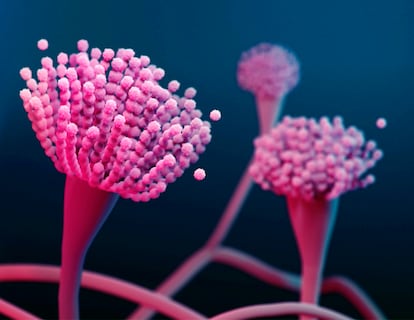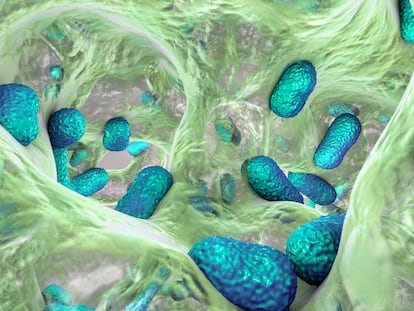What diseases are caused by fungi?
Some cause mild skin conditions such as ringworm, athlete’s foot or dandruff, and others cause more serious lung problems through inhalation of the spores

Fungi, with some very rare exceptions, are not transmitters of pathologies, but are themselves the cause of some diseases, which affect humans as well as animals and other living beings such as plants. Fungi are a very large family of organisms that sometimes look like plants, but are genetically much closer to animals.
When some fungi cause disease, it is usually to individuals who are immunocompromised, i.e., have a weak immune system: these are known as opportunists. Fungi are in the environment, usually in the form of spores. We breathe them in every day and they are part of our microbiota and of the microorganisms that are naturally on our skin. What happens in organisms that have a weak immune system is that fungi grow and reproduce much faster than normal. This is why they can cause pathologies.
There are some milder fungi, for example those related to the skin, caused by dermatophytes, which cause ringworm (well known in animals and humans), athlete’s foot or even dandruff (which is very common). But they can also cause more serious diseases, such as pulmonary pathologies due to the inhalation of the spores. An example of these is aspergillosis, which is an infection caused by Aspergillus, a common mold (a type of fungus). Another serious lung disease caused by fungus is mucormycosis. Cases of mucormycosis are currently on the rise across the world, particularly in India. Other common diseases are caused by Candida — these are called candidiasis and are the most frequent cause of vaginal yeast infections.
Fungi are also very relevant in agriculture because they can infect plants and vegetable crops in various ways: their leaves, their fruits and even their roots. These infections can ruin the crops, causing huge losses worldwide. For example, in the field of citriculture, Penicillium causes the rotting of oranges, mandarins, grapefruit, lemons, etc. Another significant example is the rice plant, the world’s most important crop, which is highly affected by the fungus Magnaporthe.
The problem now with fungi that cause plant diseases is that we are running out of sufficient fungicides to deal with the problem. There are very few antifungals, which have been used for a long time, making the fungi resistant to them. The same thing is happening in humans. Existing treatments are starting to stop working, because, just as is happening with bacteria and antibiotics, fungi have developed resistances that make antifungal drugs not so effective or ineffective altogether. For this reason, research on fungi and the development of new antifungals is very important at the moment.
Other types and uses of fungi
There are several types of fungi in nature, and not all of them cause diseases. In fact, many of them are used in food processing or for the production of compounds of industrial interest. For example, yeasts. These are unicellular, composed of a single cell. We know them mainly because they are responsible, for example, for the fermentation of bread dough, or for alcoholic fermentation, used in the production of beer, wine or cider. Then there are the filamentous fungi, which are multicellular. They are easily recognized because they have those little hairs (the so-called mycelium) on their surface, which we come across on our day-to-day. These are very interesting because among them are those of the genus Penicillium or Aspergillus, from which antibiotics have been obtained (such as penicillin). They are also used in the production of foods, such as cheese and sausages, and in the production of preservatives such as citric acid.
And finally there are the macroscopic fungi, which are those that can be seen with the naked eye and which we call mushrooms. Many are edible, others are toxic, and others are hallucinogenic because they contain compounds that cause hallucinations. Mushrooms feed mostly on organic matter, often from waste. And this makes them very interesting for the circular economy, as they are able to grow on waste, feed on it and produce other types of usable compounds. Fungi can also act as biofactories, in which products of interest for different industries are obtained from waste.
Sandra Garrigues Cubells holds a PhD in biotechnology and is a researcher at the Spanish Institute of Agrochemistry and Food Technology (IATA-CSIC).
Sign up for our weekly newsletter to get more English-language news coverage from EL PAÍS USA Edition
Tu suscripción se está usando en otro dispositivo
¿Quieres añadir otro usuario a tu suscripción?
Si continúas leyendo en este dispositivo, no se podrá leer en el otro.
FlechaTu suscripción se está usando en otro dispositivo y solo puedes acceder a EL PAÍS desde un dispositivo a la vez.
Si quieres compartir tu cuenta, cambia tu suscripción a la modalidad Premium, así podrás añadir otro usuario. Cada uno accederá con su propia cuenta de email, lo que os permitirá personalizar vuestra experiencia en EL PAÍS.
¿Tienes una suscripción de empresa? Accede aquí para contratar más cuentas.
En el caso de no saber quién está usando tu cuenta, te recomendamos cambiar tu contraseña aquí.
Si decides continuar compartiendo tu cuenta, este mensaje se mostrará en tu dispositivo y en el de la otra persona que está usando tu cuenta de forma indefinida, afectando a tu experiencia de lectura. Puedes consultar aquí los términos y condiciones de la suscripción digital.
More information
Últimas noticias
Most viewed
- Sinaloa Cartel war is taking its toll on Los Chapitos
- Oona Chaplin: ‘I told James Cameron that I was living in a treehouse and starting a permaculture project with a friend’
- Reinhard Genzel, Nobel laureate in physics: ‘One-minute videos will never give you the truth’
- Why the price of coffee has skyrocketed: from Brazilian plantations to specialty coffee houses
- Silver prices are going crazy: This is what’s fueling the rally










































